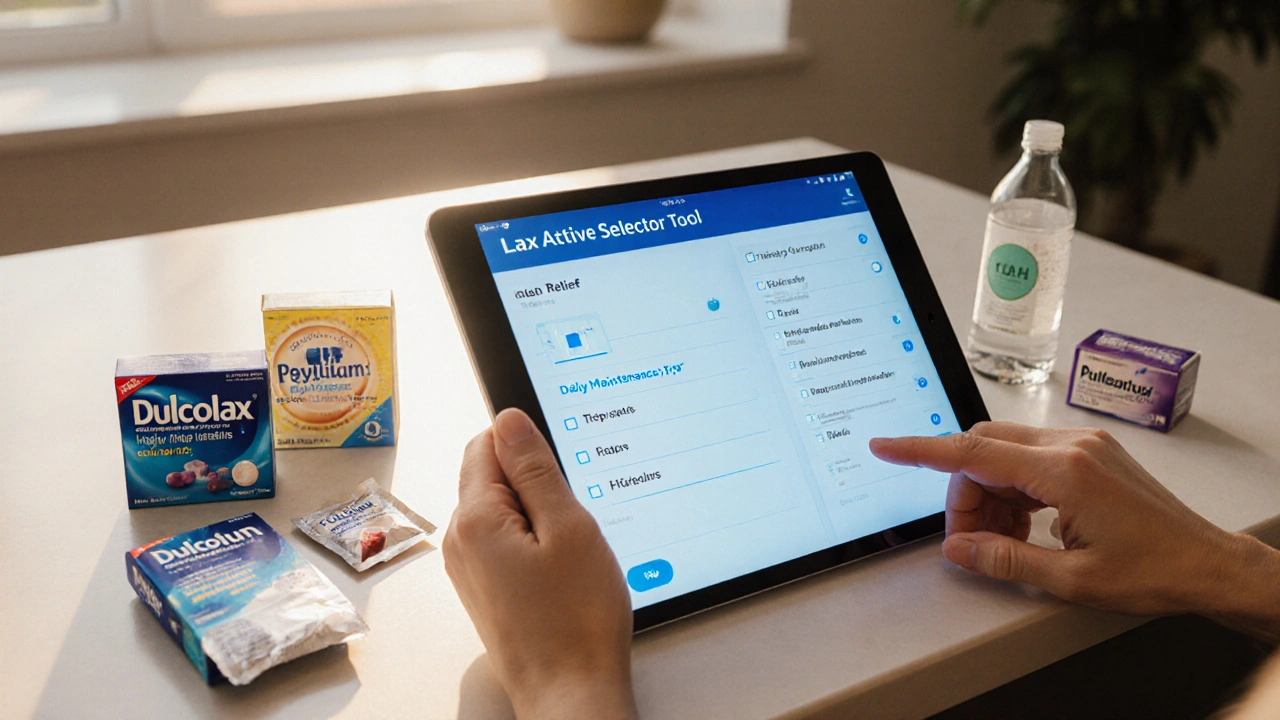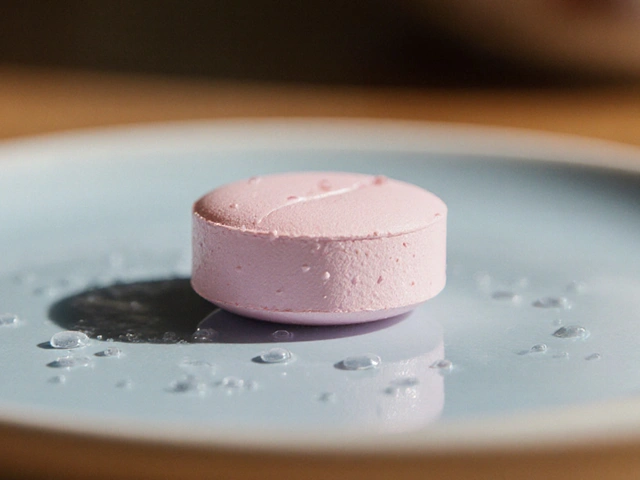Laxative Selector Tool
Recommended Laxative:
Why This Choice?
Detailed Comparison:
Mechanism: Stimulant - increases peristalsis
Onset Time: 6-12 hrs
Best For: Occasional constipation, rapid relief
Mechanism: Osmotic - draws water into intestines
Onset Time: 30 min-6 hrs
Best For: Fast relief, mild constipation
Mechanism: Osmotic polymer
Onset Time: 1-3 days
Best For: Chronic constipation, gentle daily use
Mechanism: Bulk-forming fiber
Onset Time: 12-24 hrs
Best For: Daily maintenance, mild constipation
Constipation can turn a simple day into a frustrating ordeal, and the market is crowded with pills, powders, and liquids promising fast relief. With so many options, how do you know which one truly fits your needs? Below you’ll find a side‑by‑side look at the most popular over‑the‑counter laxatives, spotlighting where Dulcolax (bisacodyl) shines and where other choices might be a better match.
Key Takeaways
- Dulcolax works quickly (6‑12hrs) and is best for occasional, short‑term relief.
- Bulk‑forming agents like psyllium are gentler and suitable for daily use.
- Osmotic laxatives (PEG, magnesium hydroxide) hydrate stool and are good for chronic constipation.
- Stimulant laxatives (senna, castor oil) can cause cramping; avoid regular use.
- Consider onset time, safety profile, and personal health conditions when picking a laxative.
What is Dulcolax (Bisacodyl)?
Dulcolax is a stimulant laxative whose active ingredient is bisacodyl. It belongs to the diphenylmethane class and works by stimulating the intestinal walls to increase peristalsis, while also drawing water into the colon. First approved in the 1950s, Dulcolax is available as oral tablets, suppositories, and pediatric drops. Typical adult dosage is 5-10mg once daily, with effects usually felt within 6-12hours.
Alternative Laxatives Covered
Below are the six most common alternatives, each introduced with a brief definition and key attributes.
Senna is a plant‑derived stimulant laxative that contains sennosides. It irritates the colon lining to trigger bowel movements, with onset in 6-12hours. Commonly sold as tablets or liquid extracts.
Magnesium hydroxide (often sold as Milk of Magnesia) is an osmotic laxative. It attracts water into the intestinal lumen, softening stool. Onset ranges from 30minutes to 6hours, depending on dosage.
Polyethylene glycol 3350 (known commercially as Miralax) is a high‑molecular‑weight polymer that retains water in the stool. It works gradually, typically within 1-3days, and is taken as a powder dissolved in liquid.
Lactulose is a synthetic disaccharide that ferments in the colon, producing osmotic pressure and soft stool. Onset is 24-48hours, making it a good option for chronic constipation.
Psyllium husk is a soluble fiber that expands with water, increasing stool bulk and promoting regularity. It works within 12-24hours and is safe for daily use.
Castor oil is a vegetable oil that acts as a strong stimulant laxative by activating intestinal receptors. Effects appear quickly (2-6hours) but often cause cramping.

Side‑by‑Side Comparison
| Laxative | Mechanism | Typical Onset | Form | Common Side Effects | Best For |
|---|---|---|---|---|---|
| Dulcolax (Bisacodyl) | Stimulant - ↑ peristalsis | 6-12hrs | Tablet, suppository, drops | Abdominal cramps, urgency | Occasional constipation, rapid relief |
| Senna | Stimulant - colonic irritation | 6-12hrs | Tablet, liquid | Cramping, possible electrolyte loss | Short‑term use, night‑time relief |
| Magnesium hydroxide | Osmotic - draws water in | 30min-6hrs | Liquid, chewable | Loose stools, hypermagnesemia (rare) | Fast relief, mild constipation |
| Polyethylene glycol 3350 | Osmotic polymer | 1-3days | Powder (drink) | Bloating, nausea | Chronic constipation, gentle daily use |
| Lactulose | Osmotic - fermentation | 24-48hrs | Syrup | Flatulence, abdominal discomfort | Long‑term management, hepatic encephalopathy |
| Psyllium husk | Bulk‑forming fiber | 12-24hrs | Powder, capsules | Bloating if not enough water | Daily maintenance, mild constipation |
| Castor oil | Stimulant - receptor activation | 2-6hrs | Liquid | Severe cramping, nausea | Rapid evacuation, occasional use only |
How to Choose the Right Laxative
Pick a product based on three practical factors:
- Onset time: Need relief tonight? Choose fast‑acting stimulants (Dulcolax, Senna) or magnesium hydroxide. For a gentle, daily schedule, go with fiber or PEG.
- Safety profile: If you have kidney disease, avoid magnesium‑based products. People prone to electrolyte imbalance should steer clear of strong stimulants.
- Usage frequency: Stimulants are fine for occasional use but can cause dependence if taken daily. Osmotics and bulk‑formers are safe for long‑term use.
Best‑Fit Scenarios
- Quick night‑time relief: Dulcolax or senna tablets taken before bedtime.
- Gentle daily maintenance: Psyllium husk mixed with water or a morning smoothie.
- Pregnancy‑safe option: PEG 3350; physician‑approved osmotic laxatives are generally considered safe.
- Patients on dialyzed kidneys: Avoid magnesium hydroxide; choose low‑dose PEG or lactulose under medical supervision.
- Travel‑related constipation: Small sachets of magnesium hydroxide or disposable Dulcolax suppositories are easy to pack.
Potential Pitfalls and Safety Tips
Even OTC laxatives can cause problems if misused. Keep these warnings in mind:
- Never exceed the recommended dose. Over‑dosing on stimulants can lead to severe cramping and electrolyte loss.
- Stay hydrated, especially with fiber‑based products. Poor water intake can worsen constipation.
- If you experience bloody stools, persistent nausea, or abdominal pain lasting more than a week, stop the laxative and see a doctor.
- Children under 12 should only use pediatric‑specific formulations of Dulcolax or other laxatives, and always follow dosing instructions.
- Combine laxatives only when advised by a healthcare professional - mixing a stimulant with an osmotic can amplify side effects.

Frequently Asked Questions
Can I use Dulcolax every day?
Dulcolax is intended for occasional relief. Daily use may lead to dependence, reduced bowel sensitivity, and electrolyte disturbances. For chronic constipation, switch to a bulk‑forming fiber or an osmotic laxative like polyethylene glycol.
Is Dulcolax safe during pregnancy?
Stimulant laxatives are generally considered safe in pregnancy when used sparingly, but the best practice is to consult your obstetrician. Many clinicians prefer bulk‑forming agents or gentle osmotics to avoid strong uterine cramping.
How does the onset of Dulcolax compare with magnesium hydroxide?
Both start working within a similar window, but magnesium hydroxide can act as fast as 30minutes, whereas Dulcolax usually needs 6-12hours to trigger a bowel movement.
Can I take Dulcolax with other medications?
Dulcolax may affect the absorption of some oral drugs due to faster transit time. Give a 2‑hour gap between taking Dulcolax and other medicines, especially antibiotics or heart medications, unless your doctor says otherwise.
What should I do if I experience severe cramping after using a laxative?
Stop the laxative immediately, hydrate with clear fluids, and apply a warm compress to the abdomen. If cramping persists for more than a few hours or is accompanied by vomiting, seek medical attention.
Choosing the right constipation aid boils down to timing, safety, and how often you need it. By matching your specific situation with the profiles above, you can avoid guesswork and get relief without unwanted side effects.






Winnie Chan
Wow, another deep dive into laxatives – just what I needed while scrolling through memes. The table is tidy, the colors are soothing, and the info is as thrilling as watching paint dry, but hey, at least it tells me Dulcolax isn’t a miracle cure. I love the friendly tone they tried to adopt, even if it feels a bit like a sales pitch from a pharmacy brochure. The quick‑relief vs. slow‑release breakdown is clear, but let’s be real: most of us just want something that works before the next Netflix binge. If you’re into the whole “avoid dependence” mantra, the fiber section is a good place to start. And yeah, the whole magnesium thing sounds like a secret weapon for travelers who can’t wait for a bathroom. All in all, solid reference for when you’re stuck on the porcelain throne and need a plan.
Kyle Rensmeyer
Sure, just take a bunch of pills and hope the universe doesn’t conspire against your bowels 😊
Rod Maine
One must acknowledge the undeniable grandeur of this compendium, albeit peppered with the occasional misspellng that adds a certain je ne sais quoi. It reads like a scholarly treatise blended with a Craigslist ad, which, frankly, is quite avant‑garde. The distinction between stimulant and osmotic agents is elucidated with the precision of a seasoned sommelier describing terroir. For those uninitiated, the chart functions as a culinary menu for your colon, except the desserts are less appealing. One can’t help but savour the nuance of dosage recommendations, though the prose sometimes wanders into the realm of arcane footnotes. In summary, a commendable effort that straddles the line between academic rigor and casual banter, despite its occasional typographical liberties.
Othilie Kaestner
Honestly, this whole “choose the right laxative” guide feels like a lazy excuse to push more over‑the‑counter meds. If you’re so concerned about safety, why not just eat actual food and fiber instead of buying chemicals? The nationalist in me says we should trust home remedies and not these imported pharmacy tricks. Plus, the “quick relief” hype is just a marketing ploy to keep us dependent on fast‑acting stimulants. You could be a bit more critical about the long‑term gut health consequences instead of handing out a shopping list.
Sebastian Samuel
Well, if you’re looking for a quick fix, the magnesium hydroxide pitch is spot on 😏. It’s portable, it works fast, and you don’t have to worry about the cramping that comes with Dulcolax. Just remember to hydrate, or you’ll swap one problem for another. And yes, the “travel‑friendly” angle is legit – nobody wants to be stuck in a foreign bathroom for hours.
Mitchell Awisus
Great effort on this guide! It’s thorough, it’s organized, and it really helps to compare onset times, mechanisms, and side‑effects, which is exactly what a person needs when they’re stuck on the porcelain throne. I especially appreciate the clear table layout, the concise bullet points, and the practical usage scenarios that cover everything from travel to pregnancy. The inclusion of safety tips, like staying hydrated with fiber‑based options, shows a responsible approach. Overall, this is a solid resource for anyone navigating the sometimes confusing world of OTC laxatives, and it could serve as a handy reference for quick decisions.
Annette Smith
Choosing the right laxative is more than just picking a pill; it is a decision that touches daily comfort, long‑term health, and even mental well‑being. First, understand that your body reacts differently to stimulant and osmotic agents. A stimulant like Dulcolax works by increasing the muscle contractions in the colon, which can give you a result within six to twelve hours. This can be helpful for occasional constipation when you need fast relief. However, relying on stimulants too often may cause your bowels to become less responsive over time. Second, osmotic laxatives such as magnesium hydroxide or polyethylene glycol add water to the stool, making it softer and easier to pass. These tend to work more gently and are better suited for regular or chronic issues. Third, fiber supplements like psyllium work by adding bulk, which stimulates natural movement. They are safest for daily use but need enough water to be effective. Fourth, consider any health conditions you have, such as kidney disease, which may limit the use of magnesium‑based products. Fifth, think about your lifestyle; if you travel a lot, a small sachet of magnesium hydroxide or a suppository might be more convenient. Sixth, always read the dosage instructions carefully to avoid over‑use, which can lead to cramping or electrolyte imbalance. Seventh, stay hydrated, especially when taking fiber‑based products, because lack of fluids can worsen constipation. Eighth, if you ever notice blood in your stool, severe pain, or symptoms lasting more than a week, stop the laxative and see a doctor. Ninth, children under twelve should only use pediatric formulations and follow dosing guidelines precisely. Tenth, avoid mixing different types of laxatives unless a medical professional advises you, as this can amplify side effects. Eleventh, keep in mind that diet, exercise, and routine are foundational; laxatives should complement, not replace, healthy habits. Twelfth, if you are pregnant, consult your healthcare provider before starting any new laxative to ensure safety for both you and the baby. Thirteenth, remember that patients with liver issues may need to avoid certain agents like lactulose. Fourteenth, be aware that some over‑the‑counter products may contain hidden ingredients, so always check the label. Fifteenth, make a personal plan based on your specific needs, weighing speed of onset, safety, and how often you expect to use it. By following these guidelines, you can select a laxative that effectively relieves constipation while preserving bowel health and overall well‑being.
beth shell
I appreciate the thoroughness of the guide and the balanced tone. The practical advice on when to use each option is useful and the safety reminders are spot on.
khushali kothari
The comparative analysis presented within this treatise exemplifies a methodical synthesis of pharmacodynamic profiles, delineating both mechanistic pathways and temporal efficacy parameters. By integrating osmotic gradients, bulk‑forming fiber dynamics, and cholinergic stimulation indices, the discourse furnishes a comprehensive decision matrix for clinicians and laypersons alike. Moreover, the inclusion of contraindication vectors, such as renal insufficiency and electrolyte homeostasis perturbations, augments the clinical applicability of the schema. In essence, this compendium operationalizes evidence‑based recommendations into a pragmatic framework, thereby facilitating nuanced therapeutic stratification.
Brandon Smith
While the article strives for neutrality, it glosses over the moral implications of encouraging over‑the‑counter self‑medication. Promoting laxatives without emphasizing dietary and lifestyle interventions may inadvertently foster a culture of quick fixes, undermining personal responsibility for health. A more ethically sound approach would prioritize holistic strategies before resorting to pharmaceuticals.
darwin ambil
All in all, great resource. It’s practical, easy to read, and the charts make comparison painless. 👍